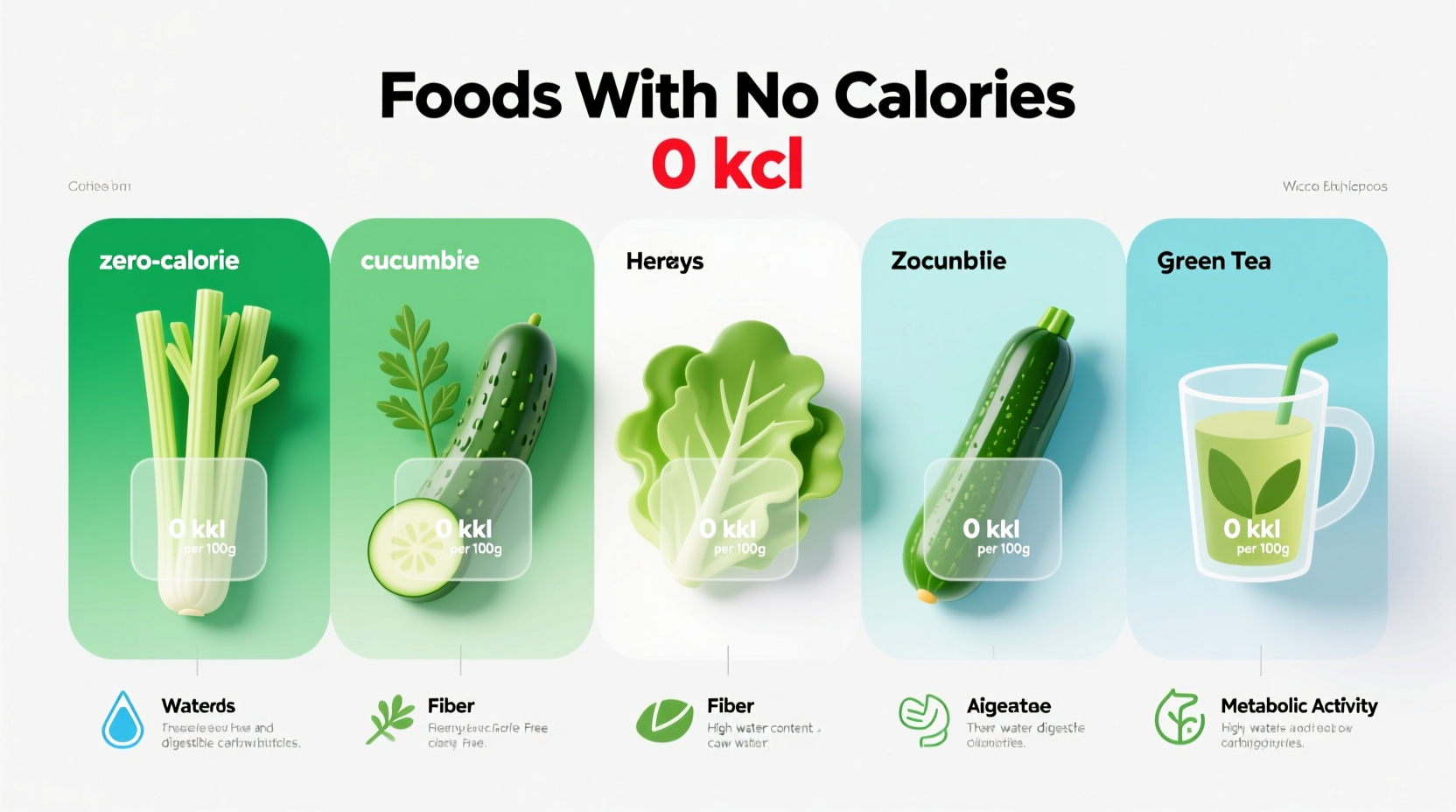The Zero-Calorie Food Myth: What Science Actually Says
When searching for "what foods contain no calories," many people hope to find magic solutions for weight management. The truth is simpler but equally valuable: while no food has literally zero calories, numerous options contain so few that they barely register in your daily energy intake. Understanding this distinction is crucial for making informed dietary choices without falling for popular nutrition myths.
Why All Foods Contain Some Calories
Calories represent the energy your body extracts from food. Even water-rich vegetables contain trace carbohydrates, proteins, or fibers that yield minimal energy. The human digestive system processes all organic matter to some degree, meaning no natural food provides absolutely zero calories. This biological reality contradicts the "negative calorie food" myth—where certain foods supposedly require more energy to digest than they provide.
| Commonly Cited "Zero-Calorie" Food | Actual Calories (Per 100g) | Primary Nutrients | Scientific Verification Source |
|---|---|---|---|
| Celery | 16 kcal | Fiber, Vitamin K, Potassium | USDA FoodData Central #01129 |
| Cucumber | 15 kcal | Water, Vitamin C, Magnesium | USDA FoodData Central #11206 |
| Lettuce (Romaine) | 17 kcal | Vitamin A, Folate, Iron | USDA FoodData Central #11251 |
| Zucchini | 17 kcal | Vitamin C, Manganese, Fiber | USDA FoodData Central #11477 |
| Radishes | 16 kcal | Vitamin C, Potassium, Calcium | USDA FoodData Central #11400 |
The Thermic Effect Reality Check
Proponents of "negative calorie foods" claim that chewing and digesting certain items like celery burns more calories than the food contains. Research from the USDA Agricultural Research Service confirms this is physiologically impossible. The thermic effect of food—the energy required for digestion—typically represents only 5-15% of a food's total caloric value. Even for very low-calorie vegetables, your body still gains a small net energy benefit.
Practical Applications for Healthy Eating
While the zero-calorie concept is scientifically inaccurate, these ultra-low-calorie foods offer genuine benefits:
- Volume eating: Fill your plate with non-starchy vegetables to increase meal satisfaction without significant calorie impact
- Nutrient density: These foods provide essential vitamins and minerals with minimal energy intake
- Hydration support: High water content (95%+) contributes to daily fluid needs
- Flavor enhancement: Add taste and texture to dishes without substantial calories

Contextual Boundaries: When Low-Calorie Foods Shine (and When They Don't)
These foods excel in specific dietary contexts but have limitations:
- Ideal for: Adding bulk to meals, managing calorie density, increasing vegetable intake, hydration-focused eating patterns
- Not sufficient as: Primary nutrition sources (lack protein, healthy fats, and some essential nutrients), sole weight loss strategy components
- Important consideration: Consuming only ultra-low-calorie foods can lead to nutrient deficiencies and insufficient energy for daily functioning
Evidence-Based Recommendations
According to the Academy of Nutrition and Dietetics, the most effective approach combines these low-calorie foods with other nutrient-dense options:
- Use non-starchy vegetables as 50% of your plate in main meals
- Pair with lean proteins and healthy fats for balanced nutrition
- Focus on overall dietary patterns rather than individual "magic" foods
- Track intake through evidence-based apps using USDA-verified databases
Common Misconceptions Debunked
Let's address popular myths about zero-calorie foods:
- Myth: "Eating celery burns calories"
- Fact: While celery has minimal calories (about 10 per stalk), your body still gains a small net energy benefit from consuming it
- Myth: "Zero-calorie foods can replace meals for weight loss"
- Fact: Sustainable weight management requires balanced nutrition, not elimination of essential nutrients
- Myth: "All vegetables have negligible calories"
- Fact: Starchy vegetables like potatoes and corn contain significant calories and should be portion-controlled
Building Sustainable Eating Habits
Instead of chasing mythical zero-calorie solutions, focus on practical strategies:
- Create colorful salads with mixed greens, cucumbers, and radishes as bases
- Add zucchini noodles to traditional pasta dishes to reduce overall calorie density
- Snack on vegetable sticks with hummus for balanced nutrition
- Use lettuce wraps instead of tortillas for lower-calorie meal options
- Hydrate with cucumber-infused water for flavor without significant calories
Final Thoughts
The search for "what foods contain no calories" reflects a common desire for simple weight management solutions. While no food has literally zero calories, incorporating ultra-low-calorie vegetables into your diet provides genuine benefits when done as part of a balanced approach. Focus on overall dietary patterns rather than individual food myths, and remember that sustainable health comes from consistent, evidence-based choices—not nutritional shortcuts.
Frequently Asked Questions
Do any foods actually have zero calories?
No natural food contains absolutely zero calories. All organic matter provides some energy value, though certain vegetables like celery and cucumbers have such minimal caloric content (typically 5-15 calories per cup) that they're nutritionally negligible in normal serving sizes.
Is the concept of negative calorie foods scientifically valid?
No, the "negative calorie food" theory is a myth. Research confirms that the thermic effect of food—the energy required for digestion—typically represents only 5-15% of a food's total caloric value. Even for very low-calorie vegetables, your body still gains a small net energy benefit.
Which vegetables have the lowest calorie content?
Celery (16 kcal/100g), cucumbers (15 kcal/100g), romaine lettuce (17 kcal/100g), zucchini (17 kcal/100g), and radishes (16 kcal/100g) are among the lowest-calorie vegetables. These provide significant volume and nutrients with minimal energy impact.
How can I use low-calorie vegetables effectively for weight management?
Use non-starchy vegetables as 50% of your plate in main meals, pair them with lean proteins and healthy fats, create vegetable-based alternatives like zucchini noodles, and use them to add volume to dishes without significantly increasing calories. This approach increases meal satisfaction while managing overall calorie intake.
Can I lose weight eating only zero-calorie foods?
No, and attempting to do so would be unhealthy. Ultra-low-calorie foods lack essential nutrients like protein, healthy fats, and certain vitamins. Sustainable weight loss requires balanced nutrition that includes adequate protein, healthy fats, complex carbohydrates, and a variety of nutrients from different food groups.











 浙公网安备
33010002000092号
浙公网安备
33010002000092号 浙B2-20120091-4
浙B2-20120091-4